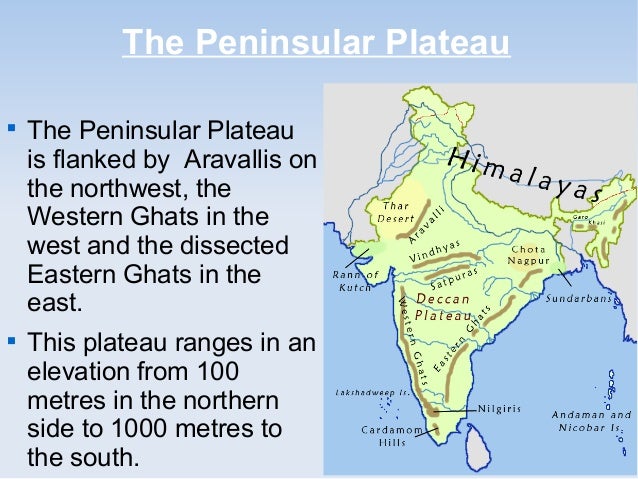The Peninsular Plateaus
- Largest of India’s physical divisions – Comprises of broad & shallow valleys with rounded hills
- Triangular in shape; composed of the oldest rocks & Surrounded by hills
- Narmada – Tapi divides it into 2 parts viz. Central highland & Deccan plateau

Division of Peninsular Plateau | |
The Central Highland
| The Deccan Plateau
|
The Central Highlands
- Lies to the north of the Narmada river between Aravali in North & Vindhya range in south
- Covers the major portion of the Malwa plateau (Madhya Pradesh)
- Rivers in this region flow from southwest to northeast; which indicates the slope of this region
- Further extension of it is Bundelkhand, Bhaghelkhand & Chhota Nagpur Plateau
- Chambal & Betwa flows through it → Region known as Bedland (Not fit for cultivation)
| Malwa Plateau |
|
| Bundelkhand Plateau |
|
| Chhotanagpur Plateau |
|
Deccan Plateau
- Largest plateau in India; Lies to the south of the Narmada River; Shaped as inverted triangle.
- Surrounded by Satpura hills, Mahadeo hills, Maikala range, Amarkantak hills and Rajmahal hills i the north; Western Ghats in the west and the Eastern Ghats in the east
- Volcanic in origin, made up of horizontal layers of solidified lava forming trap structure with step like appearance
- Sedimentary layers are also found in between the layers of solidified lava, making it inter-trapping in structure
- Average elevation of Western Ghats is 900 – 1600 metres; compared to 600 metres of Eastern Ghats
- Slopes towards east and south and descends abruptly towards west making sahayadri ranges
- The plateau is suitable for the cultivation of cotton; home to rich mineral resources & a source to generate hydroelectric power
Western Ghats
- Folded parts of Deccan Plateau
- Also known as Shayadries
- More Continuous & higher than Eastern Ghats
- Separated from coast by narrow coastal plains
- Rich watersheds give birth to large peninsular rivers like Godavari and Krishna
- Extends from Tapi in North to Kanyakumari in south
Important Passes (Rail Links)
- Thalghat → Mumbai —- Kolkata
- Bhorghat → Mumbai —- Chennai
- Phalghat → Kochi ——– Chennai
Important Hill Ranges
- Nilgiri Range (Highest peak → Doda Betta along ooty (Udhagmandalam) → TN
- Highest Peak of South India → Anaimudi From which 3 ranges radiates in 3 directions
Eastern Ghats
- Extends from Odisha to North of Nilgiri hills
- Discontinuous & lower then Western Ghats
- Do not give birth to important rivers like western ghats
- Separated from coast by very wide coastal plains
- Geologically older than western ghats
- Mahanadi, Godavari, Krishna, Kaveri cut through this range to merge with Bay of Bengal
- The Western Ghats and the Eastern Ghats meet in the Nilgiri hills
Telangana Plateau
| Karnataka Plateau
|
Dandakaranya Plateau
| Shillong Plateau
|


No comments:
Post a Comment